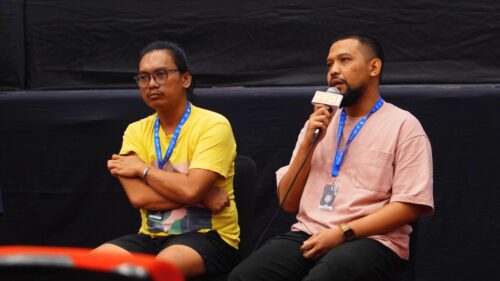The screening of The Silent Path (Soebertono Mote) (2024) on November 8, 2024 at 21.00, was followed by a discussion session with Director Yonri Revolt and Producer Rendy Rizal. Moderated by Gerry Junus, the discussion ranges from the incubation process, research, note collection, pre-production, to the film editing process. The audience unraveled every element of the film from narrative direction, stylization, and technical elements in The Silent Path (2024).
The discussion began with a question about whether or not Yonri had to pull back during the film editing process due to emotional factors. “When I was in the process of editing the film, I cried uncontrollably,” Yonri joked. “This is our principle when we make films, sad films don’t exist. Even though this film is deliberately narrated in the nuances of biography, my focus and emphasis is more on putting together a visual collage that can distinguish this biography from other films.” Rendy added, “When Pater passed away, it triggered us to finish it, and we had to create a film that was worthy of Pater and our vision of the film itself.”

Moderator Gerry Junus then asked about the process of asking the late Pater Bert for permission to make a film about him. “Even if he didn’t like my film, he couldn’t intervene in my decision, I just said I wanted to make a film about him, ‘Oh okay,’ that’s it, then we just talked about the preparations,” Yonri said. Following this statement, an audience member then discussed the reason behind the selection of archives that seemed like scattered images in The Silent Path (2024). Director Yonri then explained that the visuals were there as a companion to the audio narration. The burden of context is more directed towards the audio narration, while the scattered images become free space for the audience to imagine the direction of the story’s movement. Unlike when there is a deliberate intention to show a montage sequence, the visual duration is extended by director Yonri.
Yonri explained about the archiving of Pater Bert’s notes, which left less than 50 notes filtered in the categorization process through a chronological table based on years. Initially, the notes were organized linearly. However, in the end there was a decision to jump-cut the editing process so that the order of the notes was not sequential. The preparation of the narrative was also formulated after a research process, assisted by reference notes from interviews about Pater Bert’s journey from the beginning to the end in Papua. He explained that the source of the archive was obtained from a collection of Papuan cultural film archives dating back to 1932 sourced from a Dutch missionary organization that now focuses on the care of Papuan cultural relics.
Three audience members asked for trivial explanations about some of the film’s montages such as the scene of the rat with its head trapped in a snack wrapper, the initial scene set on the beach, and the choice of alternating between black-and-white and color scenes as a response to value-setting. One by one, Yonri explained the process of deciding on the mouse scene as a montage associated with Pater’s notes that saw how the Dutch and Indonesians saw Papua according to their interests—which was initially just a transition but was eventually used as a style to play with the image capture of Pater Bert’s notes. The sea and beach scenes at the beginning also signaled the audience to dive into Pater Bert’s travel notes. Responding to these choices, quoting Tarkovsky, Yonri stated that the visual narrative carried in black and white is film while the color one is not. In The Silent Path (2024), Yonri tries to reverse Tarkovsky’s logic by stating that the montage presented in color is the original film while the other black-and-white footage is just an accompaniment, thus justifying the mouse and sea scenes—which are in color—into a separate montage.

From the very productive interaction and discussion, a lot of perspectives and knowledge were produced by director Yonri and producer Rendy that deepened the layers and broadened the perspective to explore The Silent Path (2024). Two audience members discussed the tendency from their personal readings that the film presents the Netherlands as a superior country, perpetuating the image of Papua as an extension of the colonial system. The last question sparked opinions on the political position of the film, which alludes to the issue of Papuan independence, which is also still associated with interdependence with Western countries. “I hope I’m wrong, but the reading of this film is like that… As long as Pater Bert talked to me, my easternness and Pater’s objections never really met,” Yonri replied. Taking an example from the scene when the late Pater Bert is asked about his reasons for serving in Papua, his view that still sees Papua as the last primitive civilization on earth is enough to explain Yonri’s own opinion. Yonri also firmly positions that his film plays a clear alignment to support humanity, or to be more convincing, to support independence from all forms of colonialism.
Covered by Gantar Sinaga pada 8 November 2024. (Ed. Vanis/Trans. Naufal Shabri)



